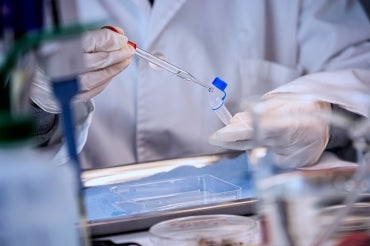Researchers' lab technique could speed forensic analysis in sexual assault cases

(photo by Science Photo Library/Getty Images)
Published: September 17, 2024
A team of researchers has developed a new approach to analyzing DNA evidence in sexual assault cases – one that could reduce lengthy delays in the processing of evidence.
While there are almost half a million sexual assaults in Canada every year, many more go unreported because victims are reluctant to come forward.
One of the reasons cited by victims is that analysis of forensic evidence is too slow.

“For this research, we read reports and surveys that asked victims why they weren’t reporting assaults,” says the study’s lead author Mohamed Elsayed, who worked on the project as part of his PhD in biomedical engineering at the University of Toronto. “And the most common answer was that they didn't have confidence in the justice system – and that lack of confidence was partly because of how long the process takes.”
Elsayed, now a post-doctoral researcher in the department of chemistry in the Faculty of Arts & Science, co-authored the study with, among others, Leticia Bodo, a master’s student in the department of chemistry, and Aaron Wheeler, a professor in the department of chemistry, the Institute of Biomedical Engineering and the Centre for Research and Applications in Fluidic Technologies, a U of T institutional strategic initiative.
All three researchers are also affiliated with the Donnelly Centre for Cellular and Biomolecular Research.
Processing forensic evidence in sexual assault cases is a technical, multi-step process that involves collecting DNA evidence and sending it to a well-equipped forensic laboratory for analysis by a skilled technician. Once there, the sample is first processed to isolate the assailant’s DNA from the victim’s so the assailant’s DNA can then be analyzed and used to identify a suspect.
The entire process can take days, weeks or longer. Most of that time is taken up with transporting the evidence to the lab, where its analysis can be further delayed depending on how many other cases are being investigated.
To speed things up, researchers focused on the first step: separating two individuals’ DNA from a single sample. At present, this is usually done manually by trained and experienced experts.
Elsayed and his collaborators, by contrast, developed a process called ’differential digestion” using digital microfluidics that helped simplify the overall process and reduce the number of manual steps needed to isolate the assailant’s DNA from 13 to five. “Also, because micro-fluidic processes tend to be faster, we expect that one of the eventual benefits will be shortening the overall time needed,” says Elsayed.
What’s more, the new approach could lead to a mobile solution that no longer requires a lab. For example, testing could be done at a hospital, circumventing the lab’s queue.
The new technique, described in a paper published in the journal Advanced Science, is compatible with the technology known as Rapid DNA analysis that is already in use for the second step of identifying an individual from their DNA. The study’s authors, which included researchers from U of T Mississauga’s forensic science program, say the long-term goal is to integrate the two technologies to make the process even more streamlined.
While there remain several challenges to deploying the new technique, Elsayed says he is confident they can be overcome and has turned his efforts toward making it widely accessible and commercially viable.
“Our plan is to develop an instrument that will do in five minutes what currently takes 45,” says Elsayed. “And to run many more samples than previously. Once we do that, the next step would be to introduce the technology to forensic labs and hospitals.
“It will take years, but the potential is very exciting.”
The research was supported by the ANDE Corporation and NSERC Alliance Society.
"I’m grateful to NSERC for having the foresight to establish the ‘Alliance Society’ program which has a mission to ‘address a societal challenge that will result in new natural sciences and engineering knowledge and societal impact,” Wheeler says.



